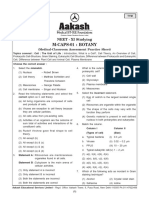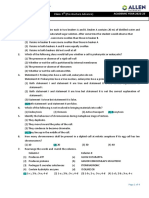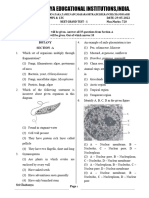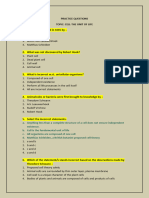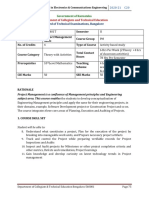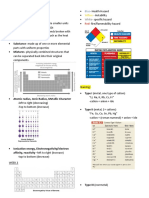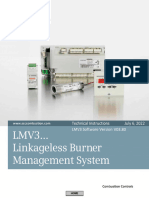BOTANY
BOTANY
Uploaded by
nitish481204Copyright:
Available Formats
BOTANY
BOTANY
Uploaded by
nitish481204Copyright
Available Formats
Share this document
Did you find this document useful?
Is this content inappropriate?
Copyright:
Available Formats
BOTANY
BOTANY
Uploaded by
nitish481204Copyright:
Available Formats
SRI CHAITANYA EDUCATIONAL INSTITUTIONS,INDIA.
A.P,TELANGANA,KARNATAKA,TAMILNADU,MAHARASHTRA,DELHI,RANCHI,CHANDIGARH
BOTANY
CELL – THE UNIT OF LIFE (4) Glycogen granules
1. The concept of “Cell is a structural and 4. The size of enucleated round and biconcave
fundamental units of life” was proposed by cells in animal cell is
(1) Aristotle (1) 0.1m (2) 1 2 m
(2) Robert Virchow (3) 10 20 m (4) 7 m
(3) Schleiden and Schwann
5. Which of the following statement about
(4) Robert Brown
bacterial cell envelope is incorrect ?
2. Given below are two statements
(1) They are glycocalyx, cell wall and
Statement - I : In bacteria flagella are surface
plasma membrane
structures without 9 + 2 arrangement of
(2) Peptidoglycan cell wall of bacteria is
microtubules
made of amino sugars
Statement – II : In bacteria all surface
(3) Plasma membrane of bacteria is entirely
structures like pili, fimbriae along with
different from eukaryotes both in structure
flagella help in locomotion
and function
In the light of above statements, choose the
(4) Glycocalyx could be an unorganized
most appropriate answer
slime layer (or) organized capsule
(1) Statement – I is true and statement – II
6. What is NOT a character of genomic DNA in
is false
bacteria ?
(2) Both statement – I and statement – II
(1) It is double stranded
are true
(2) It is circular
(3) Statement – I is false and statement – II
(3) It replicate for every 20 minutes
is true
(4) It is many in number floating in
(4) Both statement – I and statement – II
cytoplasm
are false
7. Which are absent in bacteria ?
3. Inclusion body helpful in floating in green
(1) Plasmids (2) Mesosomes
sulphur bacteria and purple green sulphur
(3) Polysomes (4) Nucleosomes
bacteria is
8. Which of the following component in
(1) Contractile vacuole
bacteria respond to grams staining
(2) Gas vacuole
procedure?
(3) Phosphate granules
(1) Cell envelope
Sri Chaitanya Page 1
(2) Plasmids 15. Which structures in bacteria help in
(3) Mesosomes photosynthesis ?
(4) Suface structure (1) Plasmids
9. A group of ribosomes present on mRNA in (2) Chromatophores
bacteria are called (3) Polysomes
(1) Polysomes (2) Mesosomes (4) Fimbriae
(3) Basal body (4) Inclusion body 16. Which is membraneless like inclusion bodies
10. Polysomes in bacteria represent but unlike inclusion bodies it is a cell
(1) one 70S ribosome on one mRNA organelle. What is it ?
(2) many 70S ribosomes on one mRNA (1) Gas vacuole
(3) one 80S ribosome on one mRNA (2) Polysome
(4) many 80S ribosomes on one mRNA (3) Phosphate granule
11. Select the wrong match (4) Cyanophycean granule
(1) Bacterial cell wall is made up of 17. Which structures perform the function of
peptidoglycan mitochondria in bacteria ?
(2) Mycoplasmas are smallest known cells (1) Nucleoid (2) Ribosomes
(3) Fimbriae help in attachment of bacteria (3) Cell wall (4) Mesosomes
(4) Amino sugars are the reserve food in 18. Motile bacteria are able to move the help of
bacteria (1) Cilia (2) Pili
12. Which is present in bacterial cell ? (3) Fimbriae (4) Flagella
(1) Histones 19. Pigmented membrane extensions in some
(2) Okazaki fragment cyanobacteria are
(3) Polysomes (1) Pneumatophores
(4) Genophore (2) Rhizophora
13. Structures help in conferring a unique (3) Chromoplasts
phenotypic characters in bacteria are (4) Chromatophores
(1) Mesosomes (2) Fimbriae 20. What is the role of capsule in bacteria
(3) Plasmids (4) Pili A) Protects it from desiccation
14. Which is absent in bacterial cell ? B) Protects it from host immune system
(1) Plasmid C) Help in attachment to bacteria to
(2) Genomic DNA surface
(3) Membrane bound organelles (1) A and B (2) B and C
(4) Cell oganelles (3) A and C (4) A, B and C
21. Glycocalyx is
Sri Chaitanya Page 2
(1) Innermost layer of cell envelope (1) 70 S ribosomes get attached to its
(2) Outermost layer of cell envelope membrane
(3) Middle layer of cell envelope (2) SER is a site of lipid synthesis
(4) Genomic DNA layer of cell envelope (3) Golgi complex arise from ER
22. Which type of substances would face (4) Prokaryotes lack - ER
difficulty to pass through cell membrane ? 26. Given below are two statements
A) Substances soluble in lipids Statement – I : All single membrane bound
B) Substances with hydrophilic moiety cell organelles in cells constitute
C) Ions/charged particles endomembrane system
D) Neutral substances Statement – II : Endomembrane system is
(1) A and B (2) B and C present in both prokaryotes and eukaryotes
(3) A and D (4) C and D (1) Statement – I is true and statement – II
23. Assertion (A) : Endoplasmic reticulum, golgi is false
complex, lysosomes and vacuoles are (2) Both statement – I and statement – II
considered as endomembrane system are true
Reason (R) : All the above cell organelles (3) Statement – I is false and statement – II
have a coordinated function (intracellular is true
transport) (4) Both statement – I and statement – II
(1) Both A and R are correct and R is the are false
correct explanation of A 27. Assertion (A) : Lysosomes actively absorb
(2) Both A and R are correct but R is NOT large amount of ions into then
the correct explanation of A Reason (R) : More ionic concentration in
(3) A is not correct but R is correct lysosomes decrease pH such that its enzymes
(4) A is correct but R is not correct work more effectively
24. What is true regarding golgi complex (1) Both A and R are correct and R is the
A) It is an important site for formation of correct explanation of A
glycolipids and glycoproteins (2) Both A and R are correct but R is NOT
B) It help in synthesis of porotein, protein the correct explanation of A
folding (3) A is not correct but R is correct
D) It is attached to nuclear membrane (4) A is correct but R is not correct
(1) A and B (2) B&C 28. Which is a part of endomembrane system?
(3) C & D (4) A&D (1) Sap vacuole
25. What is NOT true regarding ER (2) Gas vacuole
(3) Contractile vacuole
Sri Chaitanya Page 3
(4) Food vacuole (3) Cleavage of signal peptide
29. Pick the wrong match (4) Phospholipid synthesis
(1) ER : Synthesis of proteins and lipids 35. Correct sequence of origin of cell organelles
(2) GC : Synthesis of glycoproteins and from each other is
glycolipids (1) ER Golgi complex Lysosomes
(3) Lysosomes : Autolysis of a cell under (2) Nucleolus ER Golgi complex
starvation conditions (3) ER Golgi complex Ribosomes
(4) Sap vacuole : Helpful air filled cavities (4) ER Nucleus Golgicomplex
in floating in aquatic bacteria 36. Which of the following pathways are
30. Which is NOT correct regarding lysosomes ? involved in packaging of secretory proteins ?
(1) Part of endomembrane system (1) RER cis fase of GC Transface of
(2) They possess digestive enzymes the Secretory vesicles
(3) The enzymes are functionally active in (2) RER Trasnface of GC RER
basic pH Secretory vesicles
(4) They are covered by a single membrane (3) Cisace of GC transpace of GC
31. Which pair of cell organelles possess circular RER Secretory vesicles
DNA ? (4) GC Cisace of ER Transpace ER
(1) Nucleus and mitochondria Secretory vesicle
(2) Nucleus and plastids 37. Select the mis-match
(3) Plastids and mitochondria (1) Gas vacuole – Green bacteria
(4) Lysosomes and vacuoles (2) Sap vacuole – Plant cell
32. Which cell organelle is present is large (3) Contractive vacuole – Protozoans
quantities in actively dividing cells ? (4) Centrioles – Plant cells
(1) Chloroplasts (2) Mitochondria 38. Hydrolysing enzymes are present in
(3) Lysosomes (4) Vacuoles (1) Lysosomes
33. Golgi complex participate in (2) Sap vacuoles
(1) Lipid synthesis (3) Gas vacuoles
(2) Protein synthesis (4) Contractile vacuoles
(3) Formation of secretory veticles 39. Which double membrane bound cell
(4) Activation of amino acids organelles is absent in animal cells ?
34. Which of the following events events does (1) Mitochondria (2) Plastids
not occur in RER ? (3) Vacuoles (4) Sap vacuoles
(1) Protein folding
(2) Protein glycosylation
Sri Chaitanya Page 4
40. Water soluble pigments found in plant cell Column - I Column - II
vacuoles are I Aleuroplast A Stem tuber of
(1) Chlorophyll (2) Carotenoids potato
(3) Phycobilins (4) Anthocyanins II Amyloplasts B Mesophyll cells
41. Select the in correct match of leaf
(1) Centrioles : Cart wheel III Elaioplasts C Pulses
(2) Mitochondria : Sausage shaped cotyledons
(3) ER : Densely stained reticular structure IV Chloroplast D Oil seeds
(4) Golgi complex : prokaryotic cell I II III IV
42. The Lysosome plays a major role in (1) B A D C
(1) Protein synthesis (2) A B C D
(2) Conversion of energy (3) C A D B
(3) Digestion of macro and microorganic (4) D A C B
molecules 46. Incorrect statement about mitochondria
(4) Transmission of genetic characters (1) Presence of 80 S ribosomes
43. Which one of the following organelles in the (2) Folded innermembrane forming cristae
figure correctly matches with its function (3) Presence of ETS components in inner
membrane
(4) dS, circular DNA molecule in the
matrix
47. Cell organelle extracting energy from food
and store as ATP
(1) Nucleus – ATP synthesis (1) Chloroplast (2) Ribosome
(2) Chloroplast photosynthesis (3) Mitochondria (4) Vacuole
(3) Ribosome – Protein synthesis 48. Mitochondria and chloroplast are
(4) Chromosome – Carrier of genes A) Eukaryotic cell organelles with their
44. A major site of food synthesis (assimilation) own protein synthesis mechanism
is B) Energy transducing cell organelles
(1) Chloroplast which of the following options is correct ?
(2) Mitochondria (1) A is the but B is false
(3) Endoplasmic reticulum (2) A and B both are true
(4) Golgi complex (3) A and B both are false
45. Match the following organelles with (4) A is false but B is true
examples 49. Cellular organelles with membranes are
Sri Chaitanya Page 5
(1) Ribosomes, mesosomes, centrioles D Ribosomes IV Formation of
(2) Nucleolus, Ribosomes, Vacuoles packaging
(3) Nucleus, Endoplasmic reticulum, vesicles
Mitochondria A B C D
(4) Chromosomes, Ribosomes, (1) I II IV II
Centrosomes (2) II I IV III
50. Inner membrane folding of mitochondria into (3) IV III I II
the matrix are (4) IV I III II
(1) Stroma (2) Thylakoids 54. 70S ribosomes are present in
(3) Mesosomes (4) Cristae (1) ER surface, Cytoplasm of eukaryotes,
51. Plastids that possess stored food are all bacterial cell
except (2) Prokaryotic cells, chloroplast,
(1) Leucoplasts (2) Amyloplasts mitochondria
(3) chromoplasts (4) Elaioplasts (3) Chloroplast, mitochondria, rough ER
52. Cell organelle in the diagram is ___ its (4) Microbodies, mitochondria, nucleus
function is ___ 55. Non membrane bound structure among the
following
(1) Lysosome (2) Vacuole
(3) mesosome (4) Centriole
56. Cytoskeleton performs all functions in a cell
except
(1) Mechanical support
(1) Endoplasmic reticulum– Lipid synthesis (2) Motility
(2) Lysosome – Hydrolytic enzyme activity (3) Maintanance of cell shape
(3) Mitochondria – Synthesis of ATP (4) Protein synthesis
(4) Mesosomes – Increase surface area for 57. Match the following
absorption Column - I Column - II
53. Match the following I Centriole A Small structures
Column - I Column - II work like oars
A Golgi I Storehouse of II Flagella B Long, hair like
apparatus the cell structure
B Cytoskeleton II Protein synthesis III Cilia C Cartwheel like
C Vacuole III Locomotion IV Centrosome D A pair of centrioles
Sri Chaitanya Page 6
(1) I-C; II-B; III-A; IV-D B Thylakoids II Disc shaped sacs
(2) I- ; II- ; III- ; IV- in golgi
(3) I- ; II- ; III- ; IV- apparatus
(4) I- ; II- ; III- ; IV- C Centriole III Membrane
58. 9+2 array of microtubules are present in bound sacs in
(1) Centrosome, centriole chloroplast with
(2) Cilia, Flagella pigments in
(3) Peroxisome, spindle fibres membranes
(4) Nucleosome, centrosome D Acrocentric IV Part of
59. Centriole like structure called basal body chromosome centrosome with
gives rise to 9+2 arry of
(1) Micrtubules, microfilaments microtubules
(2) Cilia, flagella (1) A – II; B-III; C-IV; D-I
(3) Chromosomes, nucleolus (2) A – III; B-II; C-I; D-IV
(4) Centrosome , chromosome (3) A – II; B-IV; C-I; D-III
60. Match the following (4) A –IV; B-I; C-III; D-II
Column - I Column - II 62. Match the following
A Nuclear I Spindle Column - I Column - II
membrane formation A Nuclear I Passage through
B Smooth ER II Secretory cell membrane which movement
organelle of RNA and
C Microtubules III Lipid protein occur in
synthesis both directions
D Golgi complex IV Porous B Nuclear pore II Nucleoproteins
(1) A – IV; B-III; C-I; D-II fibres made of
(2) A – III; B-II; C-I; D-IV DNA, RNA
(3) A – IV; B-III; C-II; D-I histone and
(4) A – III; B-II; C-IV; D-I nonhistone
61. Match the following proteins
Column - I Column - II
A Cisternae I Centromere
close to end of
the chromosome
Sri Chaitanya Page 7
C Chromosome III Two membranes 66. Non membranous structure in the nucleus is
of which outer is (1) Ribosome (2) Nucleolus
continuous with (3) Centriole (4) Vacuole
ER and bears 67. Choose the correct statement about nucleolus
ribosomes on it (1) It is a non membrane bound structure
(2) Involved in DNA replication
D Chromoatin IV Physical basis of (3) It is large sized in a dividing cell
material heredity bear (4) It synthesizes lysosomes
genes and possess 68. Choose the incorrect match
centromere, (1) Telocentric chromosome – Centromere
satellite is at the end hence possess only one arm
(1) A – III; B-I; C-IV; D-III (2) Allosomes – Sex chromosomes
(2) A – III; B-II; C-I; D-IV (3) Lampbrush chromosomes – Giant
(3) A – II; B-IV; C-I; D-III chromosomes observed in diplotene stage
(4) A –IV; B-I; C-III; D-II (4) Polytene chromosomes – Chromosome
63. Location of centromere in the centre of with many chromatids observed in amphibian
chromosome possessing two equal arms is oocytes
called 69. Cristae are
(1) Submeta centric (1) Sacs in golgi
(2) Telocentric (2) Sacs instroma of chloroplast
(3) Acrocentric (3) Infolding of mitochondrial membrane
(4) Metacentric (4) Primary constriction region in
64. Function of nucleolus is chromosome
(1) Protein synthesis 70. Balbiani rings are the sites of
(2) Formation of cell plate (1) RNA and protein synthesis
(3) Synthesis of ribosomal RNA (2) Lipid synthesis
(4) Secretion of cell plate (3) Nucleotide synthesis
65. The shorter and longer arms of a (4) Physaccharide synthesis
submetacentric chromosome are refereed to 71. DNA is present in all except
as (1) Nucleus (2) Ribosome
(1) M – arm and n – arm respectively (3) Chloroplast (4) Mitochondria
(2) S – arm and k – arm respectively 72. Nuclear envelope is disintegrated and
(3) P – arm and q – arm respectively reintegrated in
(4) Q – arm and m – arm respectively (1) Prophase, Telophase
Sri Chaitanya Page 8
(2) Telophase, Prophase (1) Primary constriction
(3) S – Phase, M phase (2) Secondary constriction
(4) Metaphase, Telophase (3) Satellite body
73. Chromosome with a secondary constriction (4) Cisternae
possess all except
KEY
1) 3 2) 1 3) 2 4) 4 5) 3 6) 4 7) 4 8) 1 9) 1 10) 1
11) 4 12) 4 13) 3 14) 3 15) 2 16) 2 17) 4 18) 4 19) 4 20) 1
21) 2 22) 2 23) 1 24) 1 25) 1 26) 4 27) 1 28) 1 29) 4 30) 3
31) 3 32) 2 33) 3 34) 4 35) 1 36) 1 37) 4 38) 1 39) 2 40) 4
41) 4 42) 3 43) 3 44) 1 45) 3 46) 1 47) 3 48) 2 49) 3 50) 4
51) 3 52) 3 53) 3 54) 2 55) 4 56) 4 57) 1 58) 2 59) 2 60) 1
61) 1 62) 1 63) 4 64) 2 65) 3 66) 2 67) 1 68) 4 69) 3 70) 1
71) 2 72) 1 73) 4
BIOMOLECULES Statements-I : The long protein chain is folded
1) Glycogen doesn’t form blue colour with iodine upon itself like a hollow woolen ball giving
because rise to the tertiary structure
1) It is a helical molecule Statement-II : Tertiary structure is absolutely
2) It doesn’t contain complex helices and necessary for the many biological activities of
hence can not hold Iodine molecule proteins .
3) It breaks down when iodine reacts with it In the light of above statements, choose the
4) It is a polysaccharide correct answer from the option given below
2) Competitive inhibitors are often used in the 1) Both statements are true
control of 2) Statement I is true but statement II is false
1) Viral infections 3) Statement I is false but statement II is
2) Fungal infections correct
3) Bacterial infections 4) Both statements are true
4) Protozoan infections 4) Given below are two statements
3) Given below are two statements : Statement-I : Each enzyme shows its highest
activity at a particular temperature and
optimum pH.
Sri Chaitanya Page 9
Statement-II : Malonate is the competitive Statement-I : The chemical and physical
inhibitor of the enzyme succinate properties of amino acids are essentially of
dehydrogenase as it resembled the substrate amino carboxyl and the R functional groups.
succinate in molecular structure Statement-II : Based on number of amino and
1) Both statements are true carboxyl groups, there are acidic, basic and
2) Statement I is true but statement II is false neutral amino acids.
3) Statement I is false but statement II is In the light of above statements
correct Choose the most appropriate answer from the
4) Both statements are true options.
5) Read the following statements on lipids and 1) Both statement I and statement II are
find out the correct set of statements correct
A) Neural tissues have lipids with more 2) Both statement I and statement II are
complex structures correct
B) A fatty acid has a carboxyl group attached 3) Statement I is correct but Statement is
to an R group incorrect
C) Glycerol is one of the complex lipid which 4) Statement I is correct but statement II is
is trihydroxy propane correct
D) Lecithin is a phospholipid which has 8) Following are the statements with reference to
phosphorous and phosphorylated organic lipids and choose the correct statements;
compound A) Lipids having double bonds are saturated
E) Unsaturated fatty acids have all C-C bonds fatty acids
only B) Gingelly oil is an unsaturated fatty acid
Choose the correct answer from the option C) A fatty acid has a carboxy group attached
1) A,B,C only 2) A, D and E only to R group
3) C,D and E only 4) A,B and D only D) Glycerol has 16 carbons
6) A dehydration reaction links glucose with E) When fatty acids are esterified with
fructose molecules to produce sucrose glycerol it is called palmitic acid or
molecule. If formula for glucose and fructose arachidonic acid
is C6H12O6, then what is the formula for 1) B and E only 2) A and B only
sucrose ? 3) C and D only 4) B and C only
1) C12H25O12 G2H24O12 9) Identify the statement which is incorrect
3) C12H22O11 4) C12H24O11 1) Tryptophan possesses aromatic ring in its
7) Given below are two statements structure
2) Sulphur is an integral part of methionine
3) Lysine is an example of neutral amino acid
Sri Chaitanya Page 10
4) Serine has hydroxyl methyl group as R A B C D
group 1. II IV III I
10) Which of following is a neutral amino acid 2. II I IV III
1) Glutamic acid 2) Lysine 3. II III I IV
3) Valine 4) Aspartic acid 4. II IV I III
11. Which of the following organic compounds 15. Which of the following is a secondary
are the constituent of Glycerides ? metabolite ?
1) Arachidonic acid and glyceric acid 1) Adenosine triphosphate
2) Fatty acid and glycerol 2) Amino acid
3) Cholesterol and glycerol 3) Glucose
4) Phosphoprotein and fatty acid 4) Lemon grass oil
12. The two functional groups characteristic of 16. Match List-I with List-II
amino acid which decides chemical nature of List-I List-II
amino acid( as acidic ,basic and neutral) A. Thymine I) Lectin
1) hydroxyl and methyl groups B. Concanavalin A II) Polysaccharide
2) carbonyl and methyl groups C. Cellulose III) Toxin
3) carbonyl and phosphate groups D. Abrin IV) Pyrimidine
4) Amine and carboxyl groups Choose the correct answer from the options
13. A triglyceride molecule is formed from given below
1) one glycerol molecule and two fatty acid
A B C D
molecules
1. IV I II III
2) three glycerol molecules and three fatty
2. IV III II I
acid molecules
3. III I IV II
3) one glycerol molecule and three fatty acid
4. I IV III II
molecules
17. Which of the following are not secondary
4) three glycerol molecules and one fatty acid
metabolites in plants ?
molecule
1) Concanavalin A, Gum
14. Match the list-I with list-II
2) Abrin, Ricin
List-I List-II
3) Nucleotide, Fructose
A) Drugs i) Gums
4) Rubber, cellulose
B) Pigments ii) Curcumin
18. Identify the incorrect pair
C) Polymeric substance iii) Abrin
1) Toxin - Vinblastin
D) Toxin iv) Carotenoids
2) Terpenoides - Monoterpenes
Choose the correct answer from the options 3) Drugs - Curcumin
given below
Sri Chaitanya Page 11
4) Alkaloids - Codeine S-I : Chitin is a complex homo polysaccharide
19. Morphine is S-II : The building blocks of chitin are
1) a toxin 2) an alkaloid glucosamine molecules.
3) a drug 4) an alkaloid In the light of the above statements, choose the
20. Primary proteins are also called polypeptides correct answer from the options given below.
because 1) Both statement I and statement II are
1) they are linear chains correct
2) they are polymers of peptide monomers 2) Both statement I and statement II are
3) successive amino acids are joined by correct
peptide bonds 3) Statement I is correct but Statement is
4) they can assume many conformations incorrect
21. Which one of the following is the most 4) Statement I is correct but statement II is
abundant protein in biosphere ? correct
1) Collagen 2) RuBisCO 27. Which one of the following statements is
3) Drugs 4) Insulin wrong ?
22. Which of the following is a hormonal protein ? 1) Cytosine is a pyrimidine
1) Insulin 2) Collagen 2) Valine is a sulphur containing amino acid
3) Trypsin 4) GLUT IV 3) Inulin is a polysaccharide
23. Starch forms blue colour with iodine because 4) Insulin is a heteropolymer
1) It breaks down when iodine reacts with it 28. The cotton fibre is formed by the
2) It is a disaccharide polymerization of
3) It is a straight chain molecule 1) Glucose
4) It contains complex helices and hence can 2) N-acetyl glucosamine
hold iodine molecules 3) Fructose
24. Chitin is a polymer of 4) D-glucosamine
1) N-acetyl glucosamine 29. Given below are two statements
2) galactose S-I : A protein thread exists throughout as an
3) amino acids extended rigid rod
4) glucose S-II : Only some portions of the protein thread
25. Paper made from plant pulp is are arranged in the form of the helix
1) chitin 1) Statement I is false but statement II is true
2) cellulose 2) Both statement I and statement II are true
3) glucosamine 3) Both statement I and statement II are false
4) N-acetyl galactose amine 4) Statement I is true but statement II is false
26. Given below are two statements
Sri Chaitanya Page 12
30. α-helix and β-sheet structure given by Linus 1) Adenosine, cholesterol
Pauling is related to 2) Trypsin, Guanylic acid
1) RNA 2) Proteins 3) Cellulose, lecithin
3) triglycerides 4) DNA 4) Adenylic acid, insulin
31. Bond which is not involved in the three- 35. Which of the following biomolecules does
dimensional structure of most of proteins ? have a glycosidic bond ?
1) Hydrogen bonds 1) Amino acids in a polypeptide
2) Electrostatic interaction 2) Monosaccharides in polysaccharide
3) Hydrophobic interaction 3) Fatty acids in a diglyceride
4) Ester bonds 4) Monomers of rubber
32. Match the List-I with List-II 36. Melonate inhibits the growth of pathogenic
List-I List-II bacteria by inhibiting the activity of
A) Collagen i) No C=C double 1) Dinitrogenase
bonds 2) Succinic dehydrogenase
B) Saturated fatty ii) Phosphodiester 3) Amylase
acid bond 4) Urease
C) Dinucleotide iii) Glycosidic bonds 37. Given below are two statements
D) Sucrose iv) Peptide bonds S-I : Each enzyme shows its highest activity at
Choose the correct answer from the options optimum temperature and optimum pH
given below S-II : When binding of the chemical shuts off
1) A(ii), B(i), C(iv), D(iii) enzyme activity, the process is called
2) A(iv), B(iii), C(i), D(iv) inhibition
3) A(iv), B(i), C(ii), D(iii) 1) Statement I is false but statement II is true
4) A(i), B(iv), C(iii), D(i) 2) Both statement I and statement II are true
33. Which of the following bonds is formed as a 3) Both statement I and statement II are false
result of reaction of hydroxyl group of one 4) Statement I is true but statement II is false
nucleotide with phosphate group of other 38. Match the List-I with List-II
nucleotide with elimination of water ? List-I (Biological List-II (Biological
1) Hydrogen bond molecules) functions)
2) Glycosidic bond A. Starch i) Hormone
3) Peptide bond B. Insulin ii) Biocatalyst
4) Phosphodiester bond C. Lecithin iii) Membrane
34. Identify the substances having phosphoester component
bond and peptide bond, respectively, in their D. Trypsin iv) Storage product in
structure.
Sri Chaitanya Page 13
plants 2. III I IV II
Choose the correct answer from the options 3. III IV I II
given below 4. II III I IV
A B C D 42. Consider the following statements
1. III II IV I (A) : Coenzyme or metal ion that is tightly
2. IV II I III bound to enzyme protein is called prosthetic
3. II IV III I group
4. IV I III II B) : Protein part of an enzyme is called
39. In a reaction catalyzed by an enzyme, which coenzyme
of the following statements is correct ? Select the correct option
1) Enzymes activity decrease with every 10 1) A is false but B is true
degree increase of temperature 2) Both A and B are true
2) Enzyme-substrate complex(ES complex) 3) A is true but B is false
formation is a long durable phenomenon 4) Both A and B are false
3) Binding of enzyme induces substrate to 43. Holoenzymes differ from apoenzymes in that
alter its shape 1) they are non-protein part of enzyme
4) High temperature destroys enzyme activity 2) they (holoenzyme) consist of apoenzyme
as proteins are denatured by heat and cofactor
40. Cofactor of the proteolytic enzyme 3) they consist of protein part only
carboxypeptidase is 4) they can serve as co-factor in a number of
1) Nicotinamide adenine dinucleotide 2) Zn enzyme-catalysed reactions
3) Haem 4) niacin
41. Match the List-I with List-II 44. Which of the following statements is correct
Column-I Column-II with reference to enzymes ?
A. Promoter of catalytic I) Amino acid 1) Apoenzyme is catalytically inactive
activity 2) Coenzyme is organic molecule tightly
B. Possess glycosidic II) Cofactor bound to apoenzyme
bond 3) Cofactors are organic molecules always
C. Storage polysaccharide III) Glycogen tightly bound to apoenzyme
in animal 4) Prosthetic group consists of apoenzyme and
D. Primary metabolite IV) Starch metal ions
Choose the correct answer from the options 45. Which of the following statements regarding
given below enzyme inhibition is correct
A B C D 1) Malonate inhibits succinate dehydrogenase
non-competitively
1. II IV IIII I
Sri Chaitanya Page 14
2) In competitive inhibition, inhibitor 1) B represents activation energy with enzyme
resembles substrate molecules 2) B represents activation energy without
3) Non-competitive inhibition of an enzyme enzyme
can be overcome by adding large amount of 3) B represent potential energy of substrate
substrate 4) B represents endothermic reaction
4) Competitive inhibition is used to control 48. Which one of the following statements is
viral diseases incorrect ?
46. Which of the following enzymes is nucleic 1) The competitive inhibitor resembles the
acid ? substrate in its molecular structure
1) Polymerase 2) Ligase 2) The reaction rate reaches a minimum
3) Lysozyme 4) Ribozyme velocity (Vmax) at saturation point
47. What does B describes the given graph 3) Enzymes lower activation energy of
correctly ? reactions and enhance greatly the rate of the
reactions
4) Proteinaceous enzymes exhibit substrate
specificity
KEY
1) 2 2) 3 3) 1 4) 1 5) 4 6) 3 7) 1 8) 4 9) 3 10) 3
11) 2 12) 4 13) 3 14) 4 15) 4 16) 1 17) 3 18) 1 19) 4 20) 3
21) 2 22) 1 23) 4 24) 1 25) 2 26) 2 27) 2 28) 1 29) 1 30) 2
31) 4 32) 3 33) 4 34) 4 35) 2 36) 2 37) 2 38) 4 39) 4 40) 2
41) 1 42) 3 43) 2 44) 1 45) 2 46) 4 47) 2 48) 2 49) 50)
Sri Chaitanya Page 15
You might also like
- NET AM2 Pre Assessment Manual 21 02Document13 pagesNET AM2 Pre Assessment Manual 21 02Alin GutaNo ratings yet
- Skin To SkinDocument9 pagesSkin To SkinAsiatiNo ratings yet
- The Cell DPPDocument3 pagesThe Cell DPPakhtartanveer119No ratings yet
- Level 2 Assignement-Biological ClassificationDocument7 pagesLevel 2 Assignement-Biological ClassificationPritam KarmakarNo ratings yet
- Biological Classification Practice AssignmentDocument7 pagesBiological Classification Practice AssignmentAvishek tiadiNo ratings yet
- Practice Test 01: Botany Test Paper II (Yakeen NEET 2024)Document4 pagesPractice Test 01: Botany Test Paper II (Yakeen NEET 2024)raulomprakash2006No ratings yet
- Target Test2Document22 pagesTarget Test2amdiibhai6767No ratings yet
- Cell - The Unit of Life - DOPA Practice Sheet - (Yakeen 2.0 2023 PW Stars)Document8 pagesCell - The Unit of Life - DOPA Practice Sheet - (Yakeen 2.0 2023 PW Stars)abuzarNo ratings yet
- SR Elite, SR Aiims s60 & SR Neet MPL Neet Part Test - 4 Paper - 22!01!19Document20 pagesSR Elite, SR Aiims s60 & SR Neet MPL Neet Part Test - 4 Paper - 22!01!19Pankaj JakharNo ratings yet
- SR Elite, SR Aiims S60 & SR Neet MPL Neet Part Test - 4 Paper - 22-01-19 - PDFDocument20 pagesSR Elite, SR Aiims S60 & SR Neet MPL Neet Part Test - 4 Paper - 22-01-19 - PDFPankaj JakharNo ratings yet
- NEET Test Series 4Document28 pagesNEET Test Series 4Ara AhmedNo ratings yet
- Test Series PWDocument3 pagesTest Series PWtamannak8104No ratings yet
- Living World MCQsDocument6 pagesLiving World MCQsKoushik kanjilalNo ratings yet
- Biological Classification - Practice Sheet 04Document9 pagesBiological Classification - Practice Sheet 04wonite3114No ratings yet
- M CAPS 01 Botany (PMTcorner - In)Document4 pagesM CAPS 01 Botany (PMTcorner - In)BiniNo ratings yet
- Full Syllabus _Biology - QuestionsDocument9 pagesFull Syllabus _Biology - QuestionsShiv PratapNo ratings yet
- Class 11th - NEET - Botany - Sample Paper 4 - Rajashekar Sir - Puja Soni QuestionsDocument6 pagesClass 11th - NEET - Botany - Sample Paper 4 - Rajashekar Sir - Puja Soni QuestionsMD SAZID ALAMNo ratings yet
- Chapter-8 - The Unit of LifeDocument18 pagesChapter-8 - The Unit of LifebommanaboinabhakthasinghNo ratings yet
- Bio DppsDocument6 pagesBio DppsAlok RanjanNo ratings yet
- Target TestDocument22 pagesTarget TestMs tharshanNo ratings yet
- CELL 1Document7 pagesCELL 1Akshay SNo ratings yet
- Concept Strengthening Sheet (CSS-01) Based On AIATS-01 (TYM) - BotanyDocument4 pagesConcept Strengthening Sheet (CSS-01) Based On AIATS-01 (TYM) - Botanyashwinsingh63998No ratings yet
- Class 11th UNIT 3 Cell UnitDocument16 pagesClass 11th UNIT 3 Cell UnitSneha AggarwalNo ratings yet
- JR Aiims S60 & MPL Neet Unit Test - 1 Paper (26-07-2022)Document20 pagesJR Aiims S60 & MPL Neet Unit Test - 1 Paper (26-07-2022)anishramprasadm2No ratings yet
- DOPA 1_Cell the unit of lifeDocument5 pagesDOPA 1_Cell the unit of lifeRajeshNo ratings yet
- NEET Test Series 43Document28 pagesNEET Test Series 43anitalakshmi32No ratings yet
- (Ap & TS) SR Elite Grand Test - 5 Paper (21-03-2022)Document26 pages(Ap & TS) SR Elite Grand Test - 5 Paper (21-03-2022)srsoumyaranjantareiNo ratings yet
- Target Test (1)Document22 pagesTarget Test (1)lokemrudula05No ratings yet
- Target DPP TestDocument4 pagesTarget DPP Testxaifisaifi121No ratings yet
- M-Caps-01: Botany: NEET - XI StudyingDocument3 pagesM-Caps-01: Botany: NEET - XI StudyingAlokSinghNo ratings yet
- M-Caps-06: Botany: NEET & AIIMS - 2018-19Document3 pagesM-Caps-06: Botany: NEET & AIIMS - 2018-19Dillen JoeNo ratings yet
- B - 1: Plant Diversity, Plant Morphology, Plant Familes: DTS (Diamond Test Series) For NEET - 2020Document20 pagesB - 1: Plant Diversity, Plant Morphology, Plant Familes: DTS (Diamond Test Series) For NEET - 2020anitalakshmi32No ratings yet
- 629dbead-9532-44ae-8116-ad8928a9550fDocument18 pages629dbead-9532-44ae-8116-ad8928a9550fvijayradhasumithra24No ratings yet
- Worksheet - 4 - Biological ClassificationDocument4 pagesWorksheet - 4 - Biological ClassificationVishalNo ratings yet
- Botany - Poll 11-18Document19 pagesBotany - Poll 11-18Pranjal JaiswalNo ratings yet
- SR Elite (Ser - 2) Neet Module Test - 2 Paper (25-10-2022)Document20 pagesSR Elite (Ser - 2) Neet Module Test - 2 Paper (25-10-2022)scisyhp007No ratings yet
- JR STAR NEET CBSE UT-06 BOTANY ASSIGN QP WITH KEYDocument5 pagesJR STAR NEET CBSE UT-06 BOTANY ASSIGN QP WITH KEYjmaureenfeliciaNo ratings yet
- Test 6Document25 pagesTest 6Nannu TyagiNo ratings yet
- Cell class notesDocument4 pagesCell class notesainvestigationdepartmentNo ratings yet
- Sol Cell Unit 50 Bio Weekly 29-10-1Document5 pagesSol Cell Unit 50 Bio Weekly 29-10-1anushkakharat13No ratings yet
- BOTANY-QP (POLL-2024)Document44 pagesBOTANY-QP (POLL-2024)suhailstorm98No ratings yet
- Assignment 1 Class 9 Bio Cell Unit of LifeDocument3 pagesAssignment 1 Class 9 Bio Cell Unit of LifeL Sri MadhiNo ratings yet
- (Jp Series) Sr Neet Star Super Chaina-revision-2_model-A (Pt-5) q.p Ex.dt. 19.11.2024 (2)Document20 pages(Jp Series) Sr Neet Star Super Chaina-revision-2_model-A (Pt-5) q.p Ex.dt. 19.11.2024 (2)arunkumaran.cloudNo ratings yet
- Cell The Unit of Life Without Answer - 14411472 - 2024 - 07!28!00 - 46Document6 pagesCell The Unit of Life Without Answer - 14411472 - 2024 - 07!28!00 - 46anjusheoran340No ratings yet
- Cell-The Unit of Life - DPP-02Document3 pagesCell-The Unit of Life - DPP-02KquegehejNo ratings yet
- SR Elite, Aiims s60 & Neet MPL Neet Grand Test - 6 Paper (26!03!2022)Document24 pagesSR Elite, Aiims s60 & Neet MPL Neet Grand Test - 6 Paper (26!03!2022)srsoumyaranjantareiNo ratings yet
- Test - 01 - Cell Unit of Life - Biology - 01-11-2023 - TestDocument4 pagesTest - 01 - Cell Unit of Life - Biology - 01-11-2023 - TestHarsh BadoniyaNo ratings yet
- Cell The Unit of Life With Answer - 12945797 - 2024 - 08 - 06 - 23 - 09Document6 pagesCell The Unit of Life With Answer - 12945797 - 2024 - 08 - 06 - 23 - 09sunainadhayal420No ratings yet
- Cell and Cell Division AnswerDocument8 pagesCell and Cell Division AnswerA-0315-12 PRASHARADHA S KUMARNo ratings yet
- BotanyDocument11 pagesBotanyGirish GuptaNo ratings yet
- SR Elite, Aiims S60, MPL & LTC Neet Grand Test - 1 Paper (29-05-2022)Document28 pagesSR Elite, Aiims S60, MPL & LTC Neet Grand Test - 1 Paper (29-05-2022)srsoumyaranjantareiNo ratings yet
- 2-Biological Classification (3)B005Document4 pages2-Biological Classification (3)B005Janvi RajputNo ratings yet
- DPP LiveDocument15 pagesDPP Livep11925885No ratings yet
- PRACTICE QUESTIONS CellDocument17 pagesPRACTICE QUESTIONS CellNITIN YADAVNo ratings yet
- M-Caps-05: Botany: NEET & AIIMS 2018-19Document4 pagesM-Caps-05: Botany: NEET & AIIMS 2018-19Dillen JoeNo ratings yet
- Sri Chaitanya Grand Test - 04Document24 pagesSri Chaitanya Grand Test - 04Subhabrata Mabhai100% (1)
- Mock 1Document40 pagesMock 1milapdhruvcomputerworkNo ratings yet
- Botany Poll 11-18Document20 pagesBotany Poll 11-1810_raghpatiNo ratings yet
- Botany - Section A: Target TestDocument23 pagesBotany - Section A: Target TestNannu TyagiNo ratings yet
- Biological ClassificationDocument4 pagesBiological Classificationsumansamridhi75No ratings yet
- Siv - Microwave ProjectDocument32 pagesSiv - Microwave ProjectFahmi AbdullaNo ratings yet
- Haryana Enterprises and Employment Policy, 2020Document5 pagesHaryana Enterprises and Employment Policy, 2020Sneha DhamijaNo ratings yet
- Department of Collegiate and Technical EducationDocument15 pagesDepartment of Collegiate and Technical EducationHarsha Samagara100% (2)
- University of London La3001 ZA (266 0001) ZA Diploma in The Common Law LLBDocument5 pagesUniversity of London La3001 ZA (266 0001) ZA Diploma in The Common Law LLBemilynair19No ratings yet
- Hydrophilic Characterization of Automotive Brake FluidDocument5 pagesHydrophilic Characterization of Automotive Brake FluidWilliam KibbeNo ratings yet
- Volume of Volume 1 PDFDocument6 pagesVolume of Volume 1 PDFDoni SaputraNo ratings yet
- Lecture 9 - Parking Standards - Ar210 BCR - 9 Sept 2020Document52 pagesLecture 9 - Parking Standards - Ar210 BCR - 9 Sept 2020Tushar K100% (1)
- 15CSE370 WMC Lec 5 - Wireless Propagation ModelsDocument13 pages15CSE370 WMC Lec 5 - Wireless Propagation ModelsNithin KothapalliNo ratings yet
- TOREX Guía ModDocument2 pagesTOREX Guía ModFernandoNo ratings yet
- HVDCDocument5 pagesHVDCAlluri Appa RaoNo ratings yet
- W. H. Auden 80 Percent of The World's WastewaterDocument5 pagesW. H. Auden 80 Percent of The World's WastewaterAkshay SarjanNo ratings yet
- Ms Iso 16120 42008 Non Alloy SteelDocument13 pagesMs Iso 16120 42008 Non Alloy SteelINSTECH Consulting100% (1)
- Groom Master II 88043 Manual de Partes y MttoDocument116 pagesGroom Master II 88043 Manual de Partes y MttoCarlos VillanuevaNo ratings yet
- Conchem ReviewerDocument13 pagesConchem ReviewerMelissa PasoquinNo ratings yet
- Digital Logic FamiliesDocument19 pagesDigital Logic FamiliesThairu Muiruri100% (1)
- PHY433-chapter 2Document49 pagesPHY433-chapter 2Aidil IkhwanNo ratings yet
- Fixed-Speed and Variable-Slip Wind Turbines Providing Spinning Reserves To The GridDocument7 pagesFixed-Speed and Variable-Slip Wind Turbines Providing Spinning Reserves To The GridVivek AnandanNo ratings yet
- Katha - Upanishad - Book PDFDocument73 pagesKatha - Upanishad - Book PDFSamvit Mahashay100% (1)
- CoastalprotectionDocument19 pagesCoastalprotectionraniaNo ratings yet
- Indonesian International Medical Olympiad 2018 Indonesian International Medical Olympiad 2018Document11 pagesIndonesian International Medical Olympiad 2018 Indonesian International Medical Olympiad 2018windsondisNo ratings yet
- 05Document4 pages05CosminNo ratings yet
- Template Tesis Gaya UKM - BMDocument52 pagesTemplate Tesis Gaya UKM - BMPhilip Lionel PeterNo ratings yet
- Plant Design ProjectDocument67 pagesPlant Design ProjectBalemlay AnimutNo ratings yet
- LMV3 Technical Instructions LV3 1000 INDEXEDDocument238 pagesLMV3 Technical Instructions LV3 1000 INDEXEDOscar Yair ArenasNo ratings yet
- Retro Syn Te Tic Analysis ProblemsDocument12 pagesRetro Syn Te Tic Analysis ProblemsClara CarreraNo ratings yet
- SV - Atanasije VelikiDocument9 pagesSV - Atanasije VelikipezzillaNo ratings yet
- Structure, Form, and Architecture: The Synergy: Lecture 18: Tensile StructuresDocument21 pagesStructure, Form, and Architecture: The Synergy: Lecture 18: Tensile StructuresVrushi PatelNo ratings yet
- Ppok 2023 PDFDocument33 pagesPpok 2023 PDFBagas Trikuncoro BawonoNo ratings yet






























